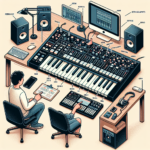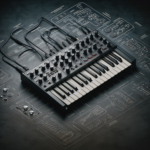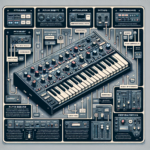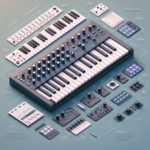Roland A-49: Comprehensive Guide to Features, Setup, and Performance

Introduction
The Roland A-49 is a versatile MIDI controller designed to meet the needs of both beginner and professional musicians. This compact yet powerful device is aimed at those who require a reliable and responsive keyboard for music production, live performances, and studio sessions. With its lightweight design and robust feature set, the A-49 is a popular choice among musicians who need a portable and efficient MIDI controller.
Roland, a well-established brand in the music industry, is known for its high-quality instruments and innovative technology. The A-49 continues this tradition, offering a range of features that cater to various musical applications.
Key Features Overview:
- 49 full-size, velocity-sensitive keys
- Lightweight and portable design
- Dedicated D-BEAM controller
- Two assignable knobs and buttons
- USB bus-powered
- Compatible with major DAWs
Design and Build Quality
Physical Design
The Roland A-49 boasts a sleek and modern design, with dimensions of approximately 836 x 182 x 84 mm and a weight of just 2.5 kg. The controller features 49 full-size, velocity-sensitive keys that provide a natural and responsive playing experience. The keys are designed to mimic the feel of an acoustic piano, making it an excellent choice for pianists transitioning to a MIDI controller.
Portability
One of the standout features of the A-49 is its portability. Weighing only 2.5 kg, it is easy to transport, making it ideal for musicians who need a reliable controller for gigs, rehearsals, and studio sessions. The compact size also ensures that it fits comfortably in most studio setups without taking up too much space.
Durability
Despite its lightweight design, the A-49 is built to withstand regular use. The high-quality materials used in its construction ensure that it remains durable and reliable over time. The keys are designed to endure extensive playing, and the overall build quality reflects Roland’s commitment to producing robust and long-lasting musical instruments.
Setup and Configuration
Initial Setup
Setting up the Roland A-49 is a straightforward process. Follow these steps to get started:
- Unbox the controller and connect it to your computer using the provided USB cable.
- Power on the controller by connecting it to a USB port on your computer.
- Ensure that your computer recognizes the device. Most modern operating systems will automatically detect and install the necessary drivers.
Software Installation
While the A-49 is designed to work seamlessly with most operating systems, you may need to install specific drivers or software for optimal performance. Visit the Roland website to download the latest drivers and software updates. Follow the on-screen instructions to complete the installation process.
Compatibility
The Roland A-49 is compatible with a wide range of operating systems and DAWs. Supported operating systems include Windows and macOS. The controller integrates smoothly with popular DAWs such as Ableton Live, FL Studio, Logic Pro, and Cubase, making it a versatile choice for various music production environments.
Features and Functionality
Key Features
The Roland A-49 offers a range of features that enhance its functionality and usability:
- 49 Full-Size Keys: The velocity-sensitive keys provide a responsive and expressive playing experience.
- D-BEAM Controller: This unique feature allows for hands-free control of various parameters, adding a new dimension to your performances.
- Assignable Knobs and Buttons: Two knobs and buttons can be customized to control different functions within your DAW or software.
- USB Bus-Powered: The controller is powered via USB, eliminating the need for an external power supply.
Customizability
The A-49 offers extensive customization options, allowing users to tailor the controller to their specific needs. MIDI mapping enables you to assign different functions to the knobs, buttons, and keys, providing greater control over your music production and performance setup.
Unique Functions
One of the standout features of the A-49 is the D-BEAM controller. This innovative feature allows you to control various parameters by simply moving your hand over the infrared beam. This hands-free control adds a unique and expressive element to your performances.
Integration with DAWs
The Roland A-49 integrates seamlessly with major DAWs, providing a smooth and efficient workflow. Whether you’re using Ableton Live, FL Studio, Logic Pro, or Cubase, the A-49 offers intuitive control over your software, making it easier to create and produce music.
Advanced Features
While the A-49 is designed to be user-friendly, it also offers advanced features for more experienced musicians. These include aftertouch, which allows for greater expression and control, and an arpeggiator, which can add rhythmic complexity to your compositions. Additionally, the chord mode enables you to play complex chords with a single key press, simplifying the process of creating rich harmonic textures.
Performance
Latency and Responsiveness
The Roland A-49 excels in terms of latency and responsiveness. The velocity-sensitive keys provide a natural and immediate response, ensuring that your playing is accurately translated into MIDI data. This low-latency performance is crucial for both studio recording and live performances, where timing and precision are essential.
Real-World Usage
In practical scenarios, the A-49 performs admirably. Whether you’re using it for live performances, studio sessions, or music production, the controller offers reliable and consistent performance. The lightweight design makes it easy to transport, while the robust build quality ensures that it can withstand the rigors of regular use.
User Experience
Overall, user feedback for the Roland A-49 is overwhelmingly positive. Musicians appreciate the controller’s responsive keys, intuitive layout, and versatile features. The D-BEAM controller is particularly praised for its unique and expressive capabilities. Users also commend the A-49’s seamless integration with various DAWs, making it a valuable addition to any music production setup.
Applications and Use Cases
Beginner vs. Professional Use
The Roland A-49 is suitable for both beginners and professionals. Its user-friendly design and intuitive features make it accessible to those new to MIDI controllers, while its advanced capabilities and customization options cater to the needs of experienced musicians.
Studio Use
In a studio environment, the A-49 excels as a reliable and versatile MIDI controller. Its responsive keys and customizable controls make it an excellent choice for music production, recording, and sound design. The seamless integration with major DAWs ensures a smooth workflow, allowing you to focus on creating music.
Live Performance
The A-49 is also well-suited for live performances. Its lightweight and portable design make it easy to transport, while the robust build quality ensures it can withstand the demands of live gigs. The D-BEAM controller adds an expressive element to your performances, allowing for dynamic and engaging shows.
Specific Genres
The Roland A-49 is versatile enough to excel in various musical genres. Its responsive keys and customizable controls make it suitable for electronic music genres such as EDM and hip-hop, where precise control over MIDI parameters is essential. Additionally, the natural feel of the keys makes it a great choice for classical and jazz musicians who require expressive and nuanced playing.
Pros and Cons
Pros:
- Lightweight and portable design
- Responsive, velocity-sensitive keys
- Unique D-BEAM controller
- Customizable knobs and buttons
- Seamless integration with major DAWs
- USB bus-powered
Cons:
- Limited number of keys (49) may not be sufficient for some users
- Lacks some advanced features found in higher-end controllers
- No aftertouch on keys
Common Issues and Troubleshooting
Known Issues
While the Roland A-49 is generally well-received, some users have reported occasional issues with driver installation and compatibility. Additionally, a few users have experienced problems with the D-BEAM controller not functioning as expected.
Troubleshooting Tips
- Driver Installation: Ensure that you have downloaded the latest drivers from the Roland website. Follow the installation instructions carefully and restart your computer if necessary.
- D-BEAM Controller: If the D-BEAM controller is not functioning correctly, check the sensitivity settings and ensure that there are no obstructions in the infrared beam’s path.
Customer Support
Roland is known for its excellent customer support. If you encounter any issues with your A-49, you can reach out to Roland’s support team for assistance. They offer comprehensive support resources, including online manuals, FAQs, and direct customer service.
Comparisons with Similar Controllers
Competitor Comparison
When compared to similar MIDI controllers from other brands, the Roland A-49 holds its own. Competitors such as the M-Audio Keystation 49 and the Novation Launchkey 49 offer similar features, but the A-49 stands out with its unique D-BEAM controller and superior build quality.
Feature Comparison
While the M-Audio Keystation 49 offers a similar key count and basic MIDI functionality, it lacks the advanced features and customization options of the A-49. The Novation Launchkey 49, on the other hand, offers more pads and controls but may not match the A-49’s build quality and key responsiveness.
Conclusion
Summary
The Roland A-49 is a versatile and reliable MIDI controller that caters to both beginners and professionals. Its lightweight design, responsive keys, and unique D-BEAM controller make it a valuable addition to any music production setup.
Who Should Buy This?
The A-49 is ideal for musicians who need a portable and efficient MIDI controller for studio use, live performances, and music production. Its user-friendly design makes it accessible to beginners, while its advanced features and customization options cater to experienced musicians.
Final Thoughts
Overall, the Roland A-49 is a well-rounded MIDI controller that offers excellent value for its price. Its combination of portability, functionality, and build quality makes it a standout choice in its category.
FAQ
Is the Roland A-49 compatible with my DAW?
Yes, the A-49 is compatible with major DAWs such as Ableton Live, FL Studio, Logic Pro, and Cubase.
Does the A-49 require an external power supply?
No, the A-49 is USB bus-powered, so it does not require an external power supply.
Can I customize the knobs and buttons on the A-49?
Yes, the A-49 offers extensive customization options, allowing you to assign different functions to the knobs and buttons.
What is the D-BEAM controller?
The D-BEAM controller is a unique feature that allows you to control various parameters by moving your hand over an infrared beam.
Is the A-49 suitable for live performances?
Yes, the A-49’s lightweight and portable design make it an excellent choice for live performances.
Where to Buy
The Roland A-49 can be purchased from various music equipment retailers, including Guitar Center, Sweetwater, and Sam Ash. It is also available from online marketplaces such as Amazon and eBay. Be sure to check for the best prices and availability from these reputable sellers.




